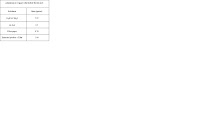Aluminum & Copper II Sulfate Redox Lab
For larger view click on image
75-100ml water
8-10g copper (II) sulfate pentahydrate (CuSO45H2O)CuSO4 • 5H2O
1. Obtain a medium sized (250 to 400ml) beaker.
2. Add 75 to 100ml of water to beaker; set-up apparatus to heat your mixture over a Bunsen burner to begin heating.
3. Measure out 8 to 10g of Copper (II) Sulfate pentahydrate (CuSO4 • 5 H2O) and record the mass in the table. Then slowly add the crystals to the heating water.
4. With a glass stirring-rod, stir the solution until the Copper II sulfate pentahydrate is dissolved.
5. While the copper sulfate crystals are dissolving one member of the group can go and get the foil. Carefully weigh out aluminum that weighs between 0.4 and 0.7 grams. Record the mass exactly into the data table (thousandths place).
6. Carefully add aluminum to the hot solution with continuous stirring until the foil is placed into the beaker.
7. Stirring frequently allow the reaction occur until you can’t see any more silvery foil pieces. This will take 15 to 20 minutes so be patient. Once you can’t see anymore foil pieces no matter how small, heat it an additional 3 to 4 minutes, then remove from heat.
8. Write your names around the outside edge of a filter paper (so you can claim it later), weigh and record the mass in the data table.
9. Use the filter paper and your funnel to filter the residue in the beaker, catching the filtrate into the Erlenmeyer flask provided.
10. Rinse out your beaker with a small (amount just covering the bottom of the beaker) of water to be sure you obtained all of the product/residue.
11. Remove the filter paper from the funnel and spread it out on a paper towel to dry overnight.
12. Clean and dry the glassware. Be sure the propane is turned off and Bunsen burner disconnected and put away. Straighten up your area.
13. Upon returning the next day. Weigh the filter paper and dry residue and record theat mass in the data table. Throw the filter paper and residue away.
Just for a HARDER thought…..
1. Write the balanced reaction equation.
2. Write the net ionic equation.
3. What is the reducing agent and what is the oxidizing agent?
4. Use the mass of Al dust and calculate the mass of the copper you theoretically would form.
5. Subtract the filter paper from the dry residue/product in the data table. This is your actual yield of copper.
6. Calculate the percent yield of this experiment.
7.Give three reasons of why the amount of copper that should have formed and the amount of copper that actually formed might be different.












